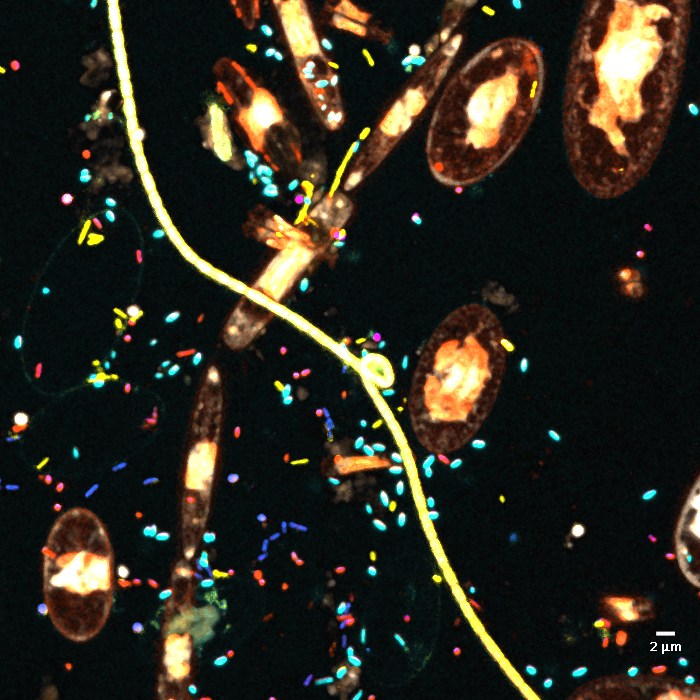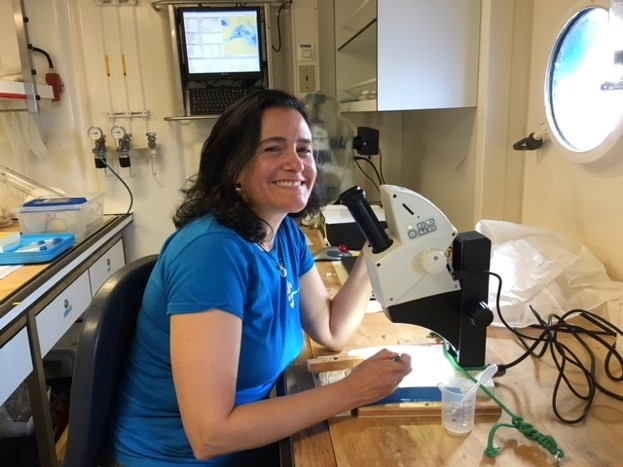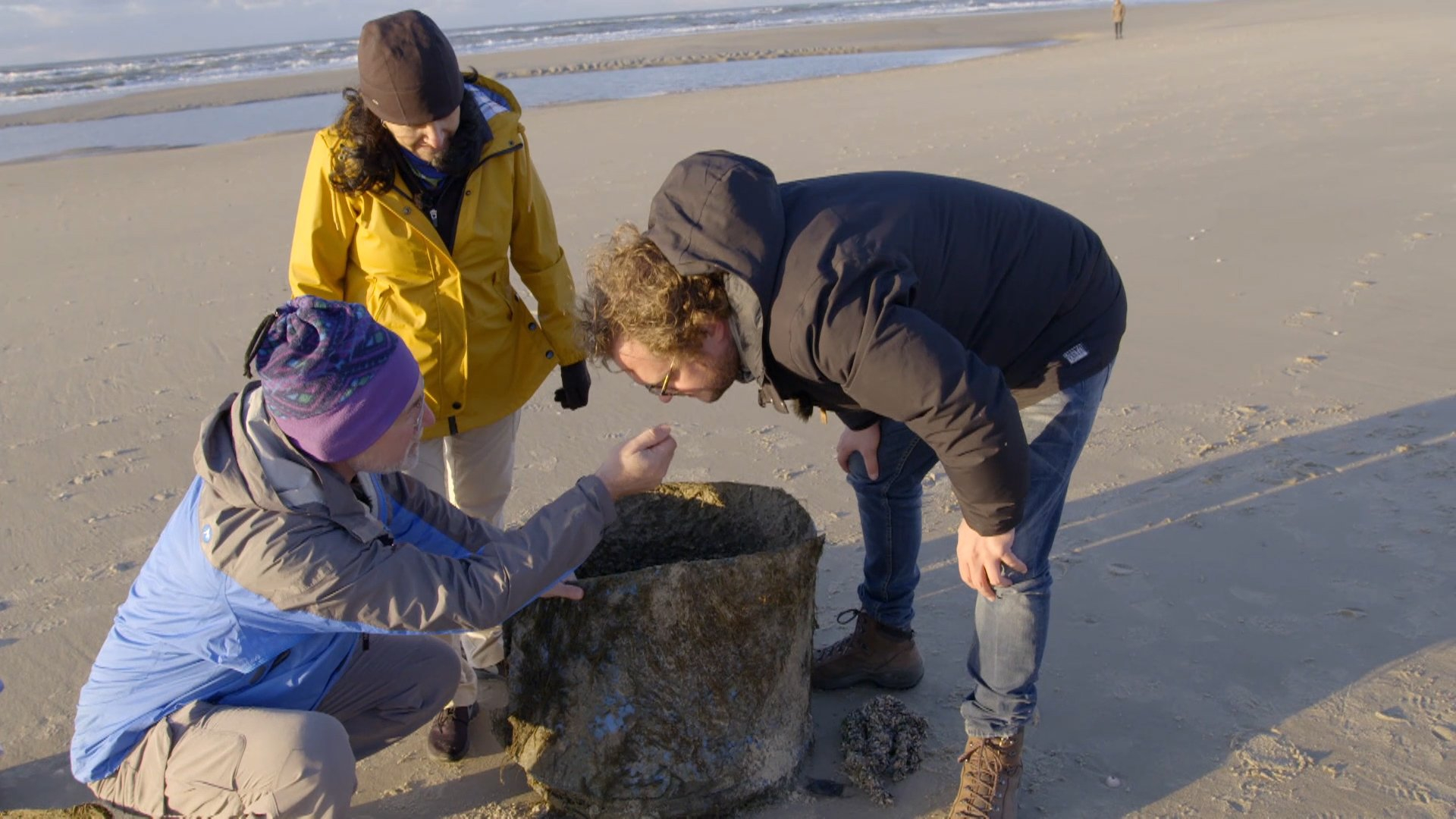Trouble on the High Seas: From Microplastics to Macroalgae

Marine biologists visualize microscopic life in the plastic soup
The research group of marine microbiologist Linda Amaral-Zettler from NIOZ and the University of Amsterdam has developed a method to visualize interactions between micro-organisms that live on marine plastic litter. The online version of the manuscript is published on November 29th, coincident with the timing of Amaral-Zettler’s inaugural speech. “With this scientific advance, we will better understand the interactions of microbial life on plastic litter.”
A new habitat: the Plastisphere
Amaral-Zettler sheds light on her research area. “The plastic soup is floating around in the ocean's gyres but also occurs in coastal zones. Apart from conspicuous items like drink bottles and shopping bags seen primarily in our coastal waters and rivers, the majority of plastic litter consists of small pieces of microplastics less than 5 mm in size. Living organisms develop a thin biofilm on the outside of these plastic surfaces. It is effectively a new habitat that we, humans, have created for bacteria and other microbes and even microscopic animals. I call this habitat the ‘Plastisphere’.”
Hundreds of types of organisms in a sample
The introduction of the new habitat invites new scientific questions. For example, how many kinds of micro-organisms colonize the plastic particles in the sea? We don’t know exactly because every piece of microplastic has a separate history.
Amaral-Zettler: “When we sample the Plastisphere in the ocean, we often find hundreds of types of different organisms. They influence one another. One group of species could produce toxins that harms another group. Yet others might have symbiotic interactions with each other, or release nutrients upon which other organisms can feed. With my research, I want to determine what groups of organisms live in the Plastisphere and what roles they play in this expanding ecosystem.”
Probing the Plastisphere
To that end, corresponding author Amaral-Zettler and her former postdoc and lead author Cathleen Schlundt (GEOMAR) along with other colleagues from NIOZ and the Marine Biological Laboratory (MBL) in Massachusetts, USA, have described a method to customize the microscopic technique CLASI-FISH for Plastisphere research. In full: Combinatorial Labelling And Spectral Imaging Fluorescence In Situ Hybridization. CLASI-FISH is based on fluorescently-labeled probes designed for different taxonomic groups of microbes. The probes bind to ribosomal RNA, which forms part of the protein building machinery in every cell.
“The CLASI-FISH technique, co-developed by co-author Dr. Jessica Mark Welch of the MBL, has typically been used to investigate the composition of oral and gut microbiomes. We too are looking at relationships between bacteria and other bacteria, and between bacteria and eukaryotes, but in our case the microbiomes come from plastic litter in the sea.” The scientific journal Molecular Ecology Resources is publishing the method online this week.
Finding new interactions
Using the CLASI-FISH approach, microbiologists hope to answer a number of new scientific questions in the future. “For example, whether organisms use the plastic as a resource, or whether the Plastisphere transports metals through the ocean via micro-organisms, influencing marine life elsewhere. And whether unknown toxins or antibiotics are released during the interactions between microbes. With this scientific advance, we will better understand the interactions of microbial life in the diversity, function, and fate of plastic litter”, says Amaral-Zettler.
Advanced imaging technology transfer to NIOZ
The biologists developed their method in part with their former lab the Woods Hole MBL. In the coming years, Amaral-Zettler will also use it in her own research at NIOZ. “Until now, I have been working in many different places. We are currently trying to acquire a microscope platform on which we can perform methods like CLASI-FISH on Texel. I can then in turn also offer UvA students the chance to learn this new method for probing the Plastisphere.”
Publication: Cathleen Schlundt, Jessica L. Mark Welch, Anna M. Knochel, Erik R. Zettler, and Linda A. Amaral-Zettler (2019). Spatial Structure in the “Plastisphere”: Molecular Resources for Imaging Microbial Communities on Marine Plastic Debris. Mol. Ecol. Resources, DOI 10.1111/1755-0998.13119.

Last spring Dr L.A. Amaral-Zettler has been named professor by special appointment of Marine Microbiology at the University of Amsterdam’s (UvA) Faculty of Science. The chair was established on behalf of NIOZ Royal Netherlands Institute for Sea Research.
Linda Amaral-Zettler’s research focuses on the relationships between microbes and the mechanisms that determine their diversity, distribution, survival and impact on local and global processes. Her research probes how microbe/environment interactions respond to natural and anthropogenic changes and the impact of microbes on ecosystems and biogeochemical processes, including pathogenicity and transformation of human pollutants. Her on-going research themes include: Microbial community assembly and function, The role of microbes as sentinels of change in the environment, Biodiversity and biogeography across the domains of life, The ecology of molecular biomarker producers, andMicrobiomes, biofilms, and the "Plastisphere".
As professor by special appointment, Amaral-Zettler will carry out research spanning scales from freshwater and local coastal environments to global comparisons across marine ecosystems. Serving as a link between the complementary expertise and resources at both NIOZ and IBED, the chair she holds will facilitate collaborative research on aquatic microbial ecology at the highest international level. Her University roles will include: introductory lectures in the Biology bachelor program; advanced lectures, supervisor and examiner roles of ‘Freshwater & Marine Biology’ MSc research projects; and, mentorship and promotion of PhD students in Marine Microbiology.
Zeebiologen visualiseren microscopisch leven in de plastic soep
De onderzoeksgroep van marien microbioloog Linda Amaral-Zettler van het NIOZ en de Universiteit van Amsterdam heeft een methode ontwikkeld om de interacties zichtbaar te maken tussen micro-organismen die leven op plastic afval in de oceaan. Het wetenschappelijke tijdschrift Molecular Ecology Resources publiceert het manuscript online op 29 november, de dag dat Amaral-Zettler haar oratie uitspreekt aan de UvA. “Met deze wetenschappelijke stap zullen we de interacties van microbieel leven op plastic afval beter kunnen begrijpen.”
Een nieuwe habitat: de Plastisfeer
Amaral-Zettler licht haar vakgebied toe. “De plastic soep drijft rond in gyres midden op de oceanen maar is ook aanwezig in veel kustgebieden. Grote stukken plastic zoals drinkflessen en zakken zien we vooral in kustwater en rivieren, maar het grootste deel van het plastic afval bestaat uit kleine, minder de 5 mm grote, deeltjes microplastic. Levende organismen hechten zich als een biofilm vast aan die oppervlakten. Het is eigenlijk een nieuwe leefplek die wij mensen hebben gecreëerd voor bacteriën en andere microben en zelfs voor microscopische dieren. Ik noem die habitat de ‘Plastisfeer’.”
Honderden typen organismen in een monster
Het ontstaan van zo’n door mensen gemaakte habitat roept nieuwe wetenschappelijke vragen op. Want hoe koloniseren de micro-organismen de plastic deeltjes in zee? We weten het niet, want elk stuk plastic heeft zijn eigen oorsprong. Amaral-Zettler: “Als wij op de oceaan de Plastisfeer bemonsteren, zitten daar vaak honderden typen organismen in. Die beïnvloeden elkaar. De ene groep soort produceert een gif dat de andere groep uitschakelt. Andere hebben juist symbiotische interacties met elkaar, of maken stoffen vrij waarvan andere organismen kunnen leven. Met mijn onderzoek wil ik vaststellen welke groepen organismen in de Plastisfeer leven en wat hun rollen zijn in deze steeds groter wordende ecosystemen.”
Honderden typen organismen in een monster
Het ontstaan van zo’n door mensen gemaakte habitat roept nieuwe wetenschappelijke vragen op. Want hoe koloniseren de micro-organismen de plastic deeltjes in zee? We weten het niet, want elk stuk plastic heeft zijn eigen oorsprong. Amaral-Zettler: “Als wij op de oceaan de Plastisfeer bemonsteren, zitten daar vaak honderden typen organismen in. Die beïnvloeden elkaar. De ene groep soort produceert een gif dat de andere groep uitschakelt. Andere hebben juist symbiotische interacties met elkaar, of maken stoffen vrij waarvan andere organismen kunnen leven. Met mijn onderzoek wil ik vaststellen welke groepen organismen in de Plastisfeer leven en wat hun rollen zijn in deze steeds groter wordende ecosystemen.”
De Plastisfeer labelen
Om dat te doen, hebben de woordvoerende auteur Amaral-Zettler haar voormalige postdoc en eerste auteur Cathleen Schlundt (GEOMAR) samen met andere collega’s van het NIOZ en het Marine Biological Laboratory (MBL) in Masschusetts, VS, een methode beschreven om de microscopische techniek CLASI-FISH geschikt te maken voor onderzoek naar de Plastisfeer. Voluit: Combinatorial Labelling And Spectral Imaging Fluorescence In Situ Hybridization. CLASI-FISH is gebaseerd op fluorescente labels voor verschillende taxonomische groepen van microben. Die markers binden zich aan het ribosomaal RNA dat deel uitmaakt van het eiwitproducerende apparaat in elke cel.
“De CLASI-FISH techniek, mede ontwikkeld door co-auteur dr. Jessica Mark Welch van MBL, werd typisch gebruikt om de samenstelling van microbiomen in de mond en darmen te onderzoeken. Ook wij bekijken de relaties tussen bacteriën onderling en met eukaryote organismen, maar in ons geval zijn de microbiomen afkomtig van plastic afval in zee.” Het wetenschappelijke tijdschrift Molecular Ecology Resources publiceert de methode op 29 november online.
Nieuwe interacties vinden
Door het gebruik van de CLASI-FISH benadering hopen de microbiologen in de toekomst een aantal nieuwe wetenschappelijke vragen te kunnen beantwoorden. “Bijvoorbeeld of de organismen het plastic ook als voedingsbodem gebruiken, of dat de Plastisfeer via micro-organismen metalen door de oceaan transporteert die zeeleven elders beïnvloeden. En of er voor ons tot nu toe onbekende toxines of juist antibiotica vrijkomen tijdens de interacties tussen microben. Met deze wetenschappelijke stap zullen we de interacties van microbieel leven in relatie tot de diversiteit, de functie en het lot van plastic afval beter kunnen begrijpen”, aldus Amaral-Zettler.
Geavanceerde beeldtechnologie bij het NIOZ
De biologen ontwikkelden hun methode gedeeltelijk samen met hun voormalige lab de Woods Hole MBL. De komende jaren zal Amaral-Zettler hem ook gaan gebruiken bij haar eigen onderzoek aan het NIOZ. “Tot op heden was ik op veel verschillende plekken aan het werk. Nu zijn we bezig om een microscoop naar Texel te halen om methodes zoals CLASI-FISH op uit te voeren. Daar kan ik dan ook studenten van de UvA de mogelijkheid bieden om deze nieuwe methode van onderzoek aan de Plastisfeer te leren.”

In haar onderzoek richt Linda Amaral-Zettler zich op de relaties tussen microben en de mechanismen die bepalend zijn voor hun diversiteit, verspreiding, overleving en impact op lokale en mondiale processen. Ze bestudeert hoe microben in interactie met hun omgeving reageren op natuurlijke en antropogene veranderingen. Ook kijkt Amaral-Zettler naar de invloed van microben op ecosystemen en biogeochemische processen, waaronder pathogeniteit en omzetting van door de mens geproduceerde vervuilers. Tot haar lopende onderzoeksthema's behoren: samenstelling en functie van microbiële gemeenschappen; de rol van microben als poortwachters van veranderingen in het milieu; biodiversiteit en biogeografie op alle levensgebieden; de ecologie van de makers van moleculaire biomarkers; en microbiomen, biofilms en de 'plastisfeer'.
Aan de UvA gaat Amaral-Zettler onderzoek doen binnen een breed scala van zoetwater- en lokale kustmilieus tot wereldwijde vergelijkingen tussen mariene ecosystemen. Als bijzonder hoogleraar vormt zij de schakel tussen de expertise en middelen van het NIOZ en het Instituut voor Biodiversiteit en Ecosysteem Dynamica (IBED), zodat de twee instituten gemeenschappelijk onderzoek kunnen doen naar aquatische microbiële ecologie.
Daarnaast gaat Amaral-Zettler inleidende colleges geven binnen de bacheloropleiding Biologie en gespecialiseerde colleges binnen de mastertrack Freshwater & Marine Biology. Ook zal zij masterstudenten begeleiden bij onderzoeksprojecten en optreden als begeleider van promovendi in de mariene biologie.